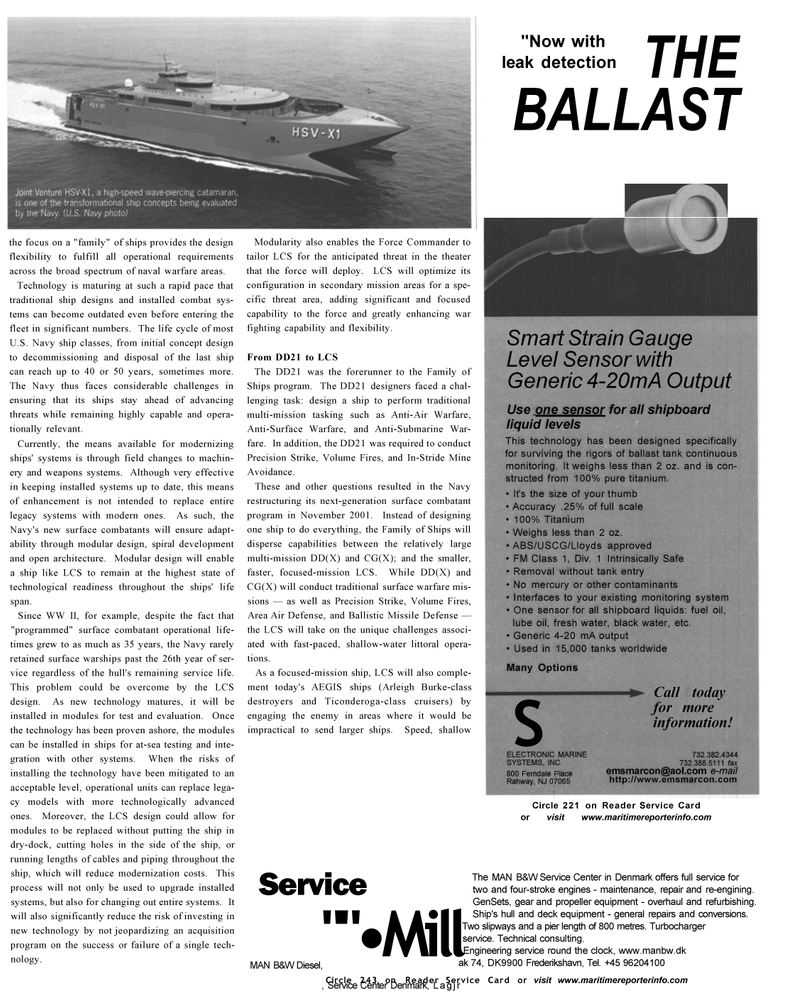
Page 29: of Maritime Reporter Magazine (October 2002)
Read this page in Pdf, Flash or Html5 edition of October 2002 Maritime Reporter Magazine
"Now with leak detection THE
BALLAST
Service ""•Mill , Service Center Denmark, Lagjr
MAN B&W Diesel,
The MAN B&W Service Center in Denmark offers full service for two and four-stroke engines - maintenance, repair and re-engining.
GenSets, gear and propeller equipment - overhaul and refurbishing.
Ship's hull and deck equipment - general repairs and conversions.
Two slipways and a pier length of 800 metres. Turbocharger service. Technical consulting.
Engineering service round the clock, www.manbw.dk ak 74, DK9900 Frederikshavn, Tel. +45 96204100 the focus on a "family" of ships provides the design flexibility to fulfill all operational requirements across the broad spectrum of naval warfare areas.
Technology is maturing at such a rapid pace that traditional ship designs and installed combat sys- tems can become outdated even before entering the fleet in significant numbers. The life cycle of most
U.S. Navy ship classes, from initial concept design to decommissioning and disposal of the last ship can reach up to 40 or 50 years, sometimes more.
The Navy thus faces considerable challenges in ensuring that its ships stay ahead of advancing threats while remaining highly capable and opera- tionally relevant.
Currently, the means available for modernizing ships' systems is through field changes to machin- ery and weapons systems. Although very effective in keeping installed systems up to date, this means of enhancement is not intended to replace entire legacy systems with modern ones. As such, the
Navy's new surface combatants will ensure adapt- ability through modular design, spiral development and open architecture. Modular design will enable a ship like LCS to remain at the highest state of technological readiness throughout the ships' life span.
Since WW II, for example, despite the fact that "programmed" surface combatant operational life- times grew to as much as 35 years, the Navy rarely retained surface warships past the 26th year of ser- vice regardless of the hull's remaining service life.
This problem could be overcome by the LCS design. As new technology matures, it will be installed in modules for test and evaluation. Once the technology has been proven ashore, the modules can be installed in ships for at-sea testing and inte- gration with other systems. When the risks of installing the technology have been mitigated to an acceptable level, operational units can replace lega- cy models with more technologically advanced ones. Moreover, the LCS design could allow for modules to be replaced without putting the ship in dry-dock, cutting holes in the side of the ship, or running lengths of cables and piping throughout the ship, which will reduce modernization costs. This process will not only be used to upgrade installed systems, but also for changing out entire systems. It will also significantly reduce the risk of investing in new technology by not jeopardizing an acquisition program on the success or failure of a single tech- nology.
Modularity also enables the Force Commander to tailor LCS for the anticipated threat in the theater that the force will deploy. LCS will optimize its configuration in secondary mission areas for a spe- cific threat area, adding significant and focused capability to the force and greatly enhancing war fighting capability and flexibility.
From DD21 to LCS
The DD21 was the forerunner to the Family of
Ships program. The DD21 designers faced a chal- lenging task: design a ship to perform traditional multi-mission tasking such as Anti-Air Warfare,
Anti-Surface Warfare, and Anti-Submarine War- fare. In addition, the DD21 was required to conduct
Precision Strike, Volume Fires, and In-Stride Mine
Avoidance.
These and other questions resulted in the Navy restructuring its next-generation surface combatant program in November 2001. Instead of designing one ship to do everything, the Family of Ships will disperse capabilities between the relatively large multi-mission DD(X) and CG(X); and the smaller, faster, focused-mission LCS. While DD(X) and
CG(X) will conduct traditional surface warfare mis- sions — as well as Precision Strike, Volume Fires,
Area Air Defense, and Ballistic Missile Defense — the LCS will take on the unique challenges associ- ated with fast-paced, shallow-water littoral opera- tions.
As a focused-mission ship, LCS will also comple- ment today's AEGIS ships (Arleigh Burke-class destroyers and Ticonderoga-class cruisers) by engaging the enemy in areas where it would be impractical to send larger ships. Speed, shallow
Circle 221 on Reader Service Card or visit www.maritimereporterinfo.com
Smart Strain Gauge
Level Sensor with
Generic 4-20mA Output
Use one sensor for all shipboard liquid levels
This technology has been designed specifically for surviving the rigors of ballast tank continuous monitoring. It weighs less than 2 oz. and is con- structed from 100% pure titanium. • It's the size of your thumb • Accuracy .25% of full scale • 100% Titanium • Weighs less than 2 oz. • ABS/USCG/Lloyds approved • FM Class 1, Div. 1 Intrinsically Safe • Removal without tank entry • No mercury or other contaminants • Interfaces to your existing monitoring system • One sensor for all shipboard liquids: fuel oil, lube oil, fresh water, black water, etc. • Generic 4-20 mA output • Used in 15,000 tanks worldwide
Many Options
S
ELECTRONIC MARINE
SYSTEMS, INC. 800 Ferndale Place
Rahway, NJ 07065
Call today for more information! 732.382.4344 732.388.5111 fax [email protected] e-mail http://www.emsmarcon.com
Circle 243 on Reader Service Card or visit www.maritimereporterinfo.com

 28
28

 30
30
